Wuhan (Day 4 - part 2)
Musical instruments
China has had a long musical history, at least 7,000 years old. Unfortunately, music is fleeting and often lost in the passage of time. As a result, it is very hard to explore the orgins and development of ancient music. Furthermore, most of the ancient instruments are found in bad or unrepairable condition. The few that have survived, however, help give us an idea of the sound of ancient times.
The tomb of Marquis Yi is often considered to be one of the most important finds in the history of world music. It contained eight kinds of ancient musical instruments amounting to 125 pieces. A flood had filled the tomb with water, which not only deterred tomb robbers but also helped with their incredible preservation.
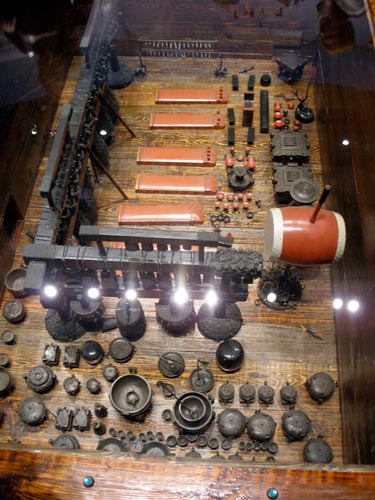
A model layout of the central chamber of the tomb, showing the positions of the numerous instruments found.
The tomb had four chambers covering an area of over 2,300 square feet. It was a virtual underground music palace. Along with the Marquis' coffin were 21 other coffins, each filled with a young girl between the age of 13 to 25. Presumably they were musicians and dancers, all buried (after being poisoned) along with the instruments and their deceased master.
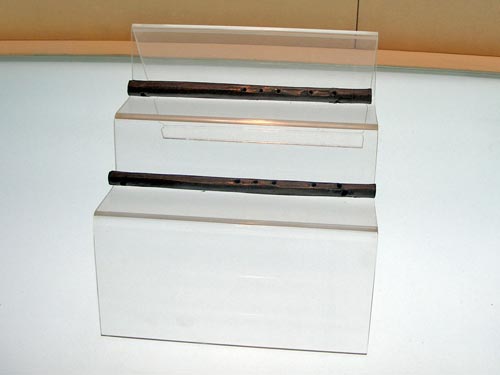
One of China's oldest instruments, the Chi is a wind instrument made of bamboo. Historically, Chinese musical instruments were categorized into eight groups according to the material from which they were made: metal, stone, silk, bamboo, gourd, pottery, leather, and wood. These are the oldest and only ones of their kind ever discovered.
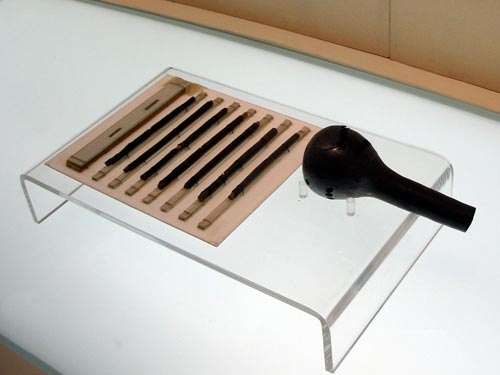
The Sheng is a wind instrument with several pipes. It first appeared in the Shang Dynasty over 3,000 years ago. This one is made out of a gourd and is the oldest one of its type ever discovered in China. The pipes fragments next to the gourd were originally inserted into it.
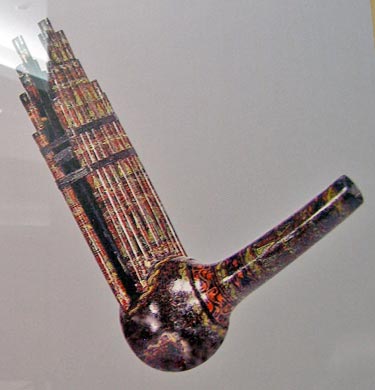
This is how it used to look.
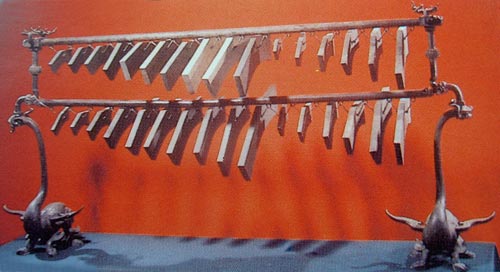
The Bian Qing is a set of stones chimes. In ancient times, it was used only in the Huanghe (Yellow) River basin. Gradually its popularity spread and it was developed into a kind of fine tone instrument during the Spring & Autumn Period (770 - 476 BC). The 32 sonorous stones are suspended on a sturdy bronze frame. This is a reproduction. This picture is taken from the Unique Music of Great Antiquity CD.
Chime Bells:
Perhaps the most magnificent of the recovered instruments is that of the Bian Zhong (the bronze Chime Bells), the largest bronze musical instrument ever discovered. Suspended on a large L-shaped bronze and wood frame, the 65 bells weigh over 5,500 pounds, with the largest bell close to 450 pounds and the smallest around 5 pounds.
Arranged in three rows according to their pitch, each bell can play two notes. This is possible because the bells have an almond-shaped cross-section. The instrument required five people, who each struck the different bells with wooden mallets. There are about 3,000 ancient Chinese characters on the bells, describing the music and the owner of this instrument.
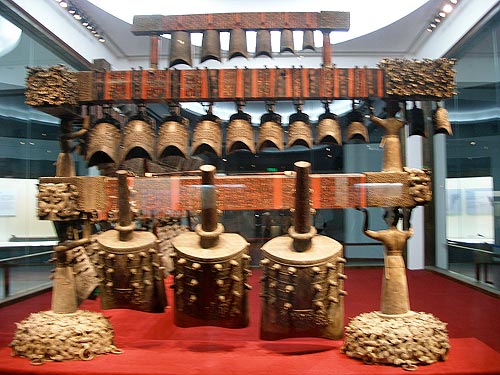
The magnificent Chime Bells

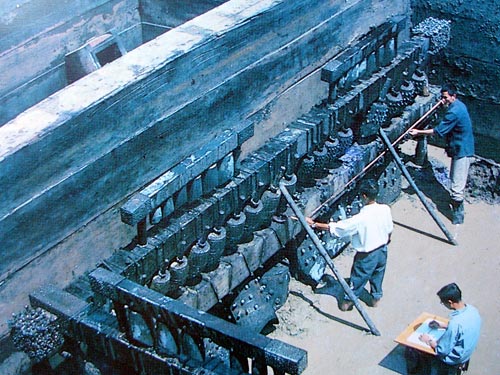
Excavating the Chime Bells. (Picture is from the Unique Music of Great Antiquity CD.)
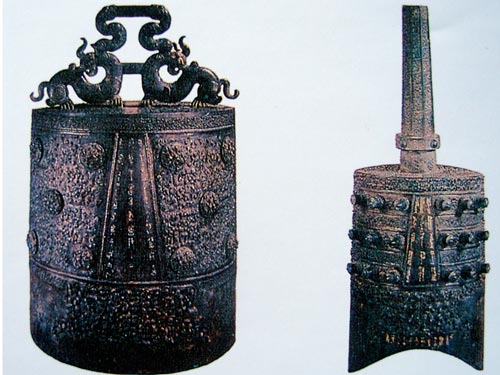
Above are a Bo bell (a type of large round bell) and a Yong bell (a squashed cylinder bell with a handle). (Picture is from the Unique Music of Great Antiquity CD.)
The first type of bells were baked out of pottery clay. Eventually bronze ones appeared during the Shang Dynasty (1600 - 1046 BC). But these types of bells only produced a sound when the clapper was rocked to strike the inner wall, so it was not so easy to control the rhythm. So new bell types were created that could be struck from the outside.
This is an excerpt from a widespread ancient folk song called Zhu Zhi Chi. It describes their forefathers' deep love for life and yearning for happiness. Arranged by Wang Yuanping, it combines both the Bian Zhong (Chime Bells) and the Bian Qing (stones chimes).
There is a daily performance at the museum where musicians wearing ancient clothes play a replica (one of four copies) of the Chime Bells.
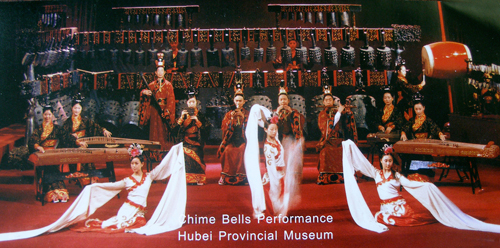
Click on this ticket stub for a closer view of the instruments
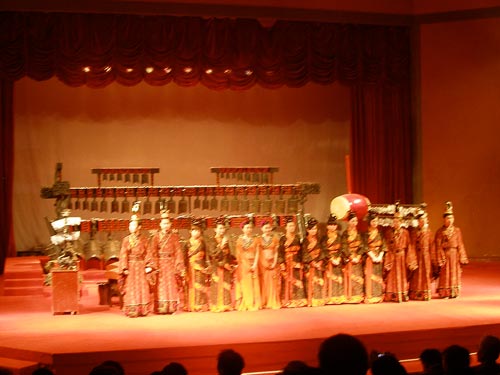
The performers
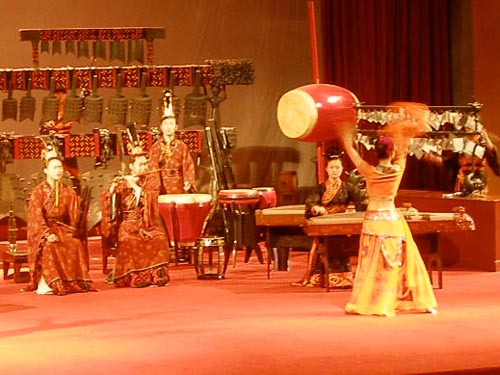
Musicians play and ladies dance. One man plays a type of flute while a woman plays a zither (or guzheng). Other musicians play the Chime Bells (in the background) and the stones chimes (to the right).

Beauty for both the eye and ear
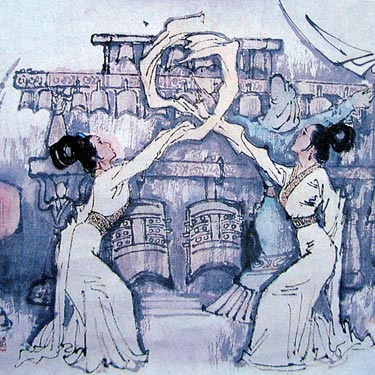
(Picture is from the Unique Music of Great Antiquity CD.)
Writing
The earliest examples of Chinese ink writings on bamboo (Zhujian) were discovered in the tomb. They recorded the people who attended the Marquis' funeral, such as the officials and royalty of the Chu and Zeng states, and also included details of their transportation such as number of horses carrying the chariots. These bamboo slips provide important information on the development of Chinese brush calligraphy.
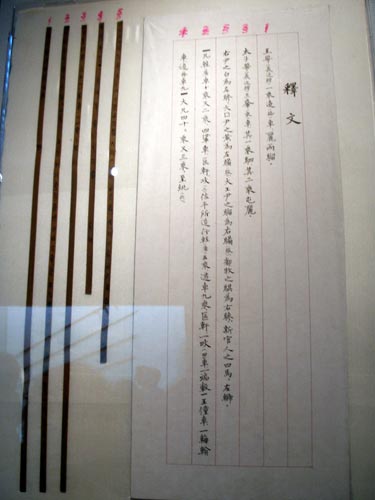
Bamboo slips (left) and their translations
Military
The museum also includes various ancient weapons of the Chu State.
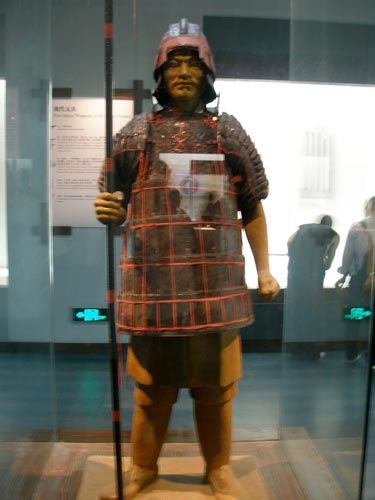
A soldier dressed in battle armor made of leather and lacquer. The outfit is actually very light-weight.
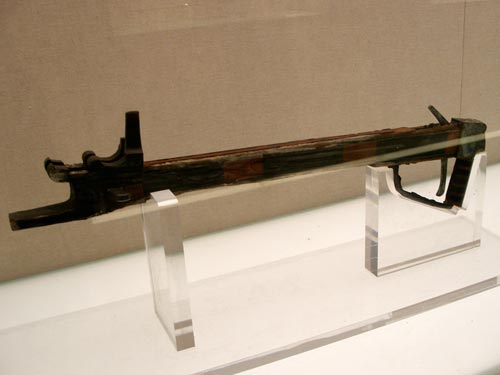
An ancient crossbow
In 2002, archaeologists discovered pieces of chariots and horses from the Chu state. After careful restoration, some of them are now displayed.
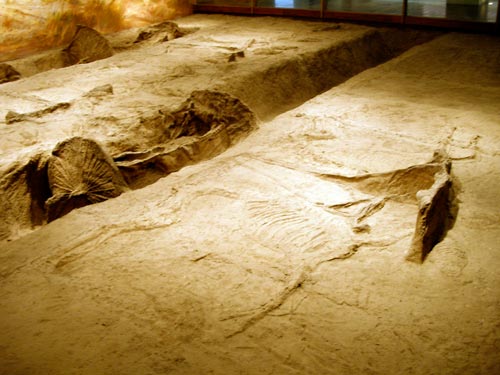
A yoke still harnesses two horses even in death.
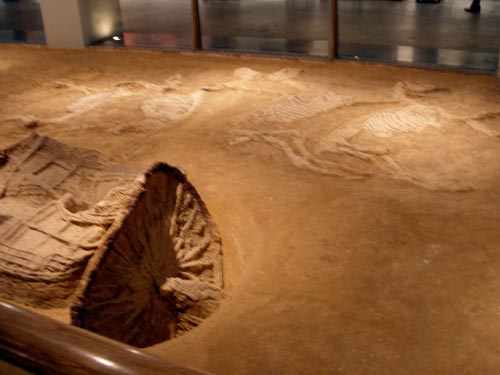
Next came a lovely lunch.
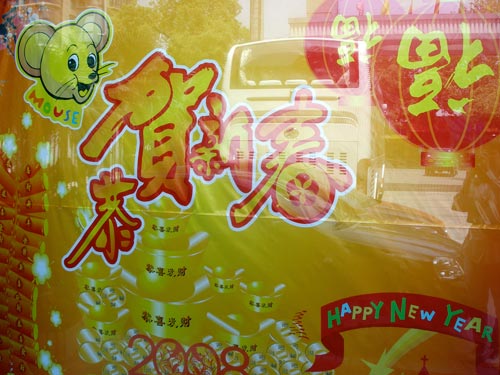
The year of the... mouse, apparently. The Chinese word for this animal may be translated as 'rat', 'mouse', or more broadly, 'rodent'.
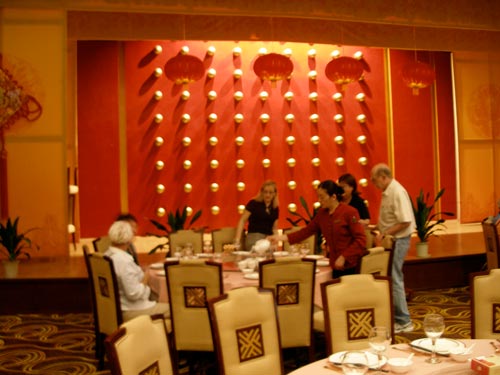
Note the nine rows of nine golden knobs on the wall, as seen in the Forbidden City
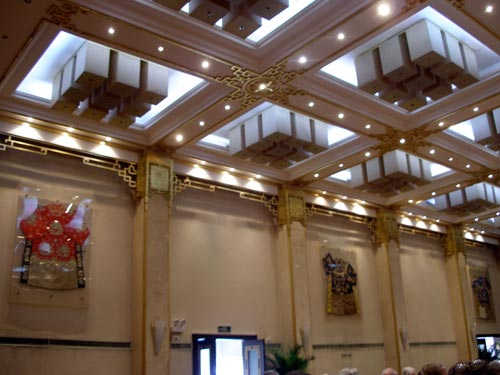
Ornate traditional outfits lined the wall
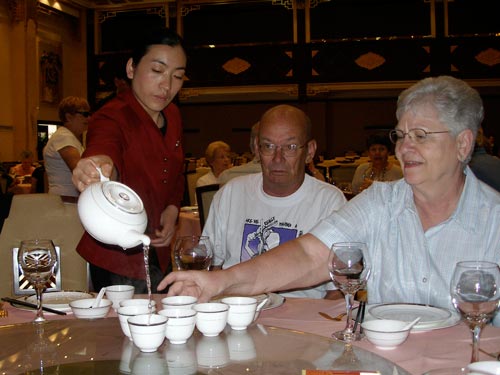
Tea
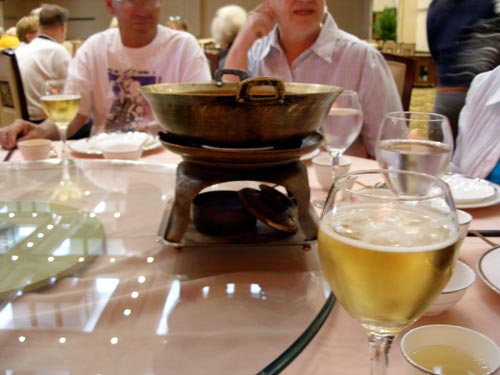

All the seafood was very fresh here.
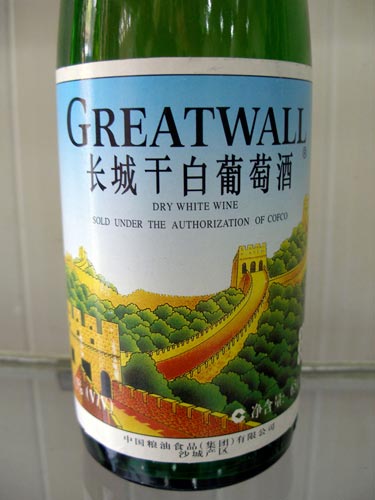
A popular wine at the local liquor store
After lunch, we drove to the other end of town to visit the Rock & Bonsai Museum. Throughout the day, we covered the city from end to end. In some sections of town, Wuhan gives the feel of a small city...

Mopeds parked in front of tiny shops

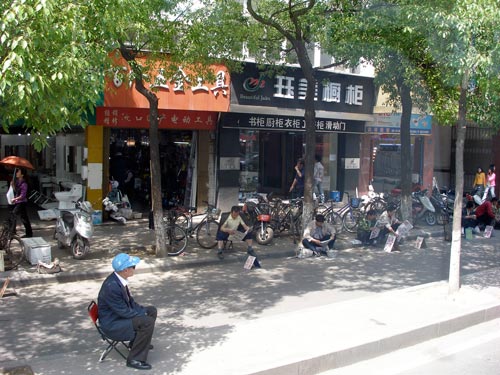
Locals hanging out
In other sections, it felt like a giant metropolis....
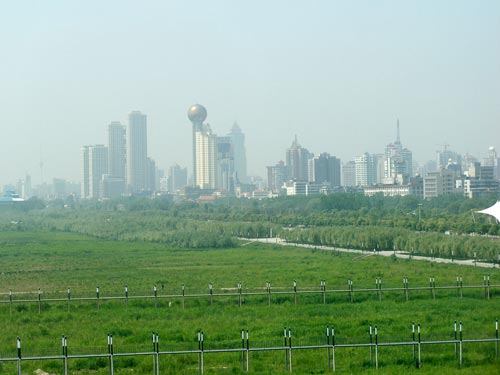
An impressive (albeit hazy) skyline

Small old buildings getting torn down to make way for highrises.
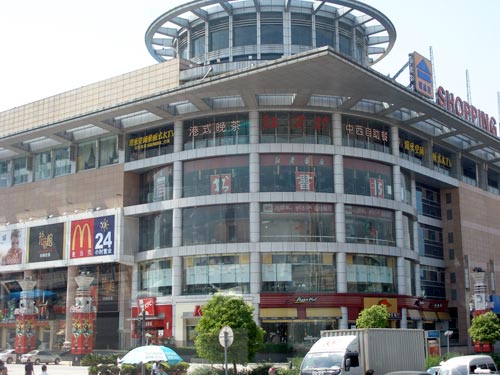
Fast food restaurants and giant shopping malls

Elevated pedestrian crosswalks are needed at the giant intersections.

Scrolling advertisements cross the back of this taxi.
Wuhan lies at the confluence of the Yangtze and Han Rivers. One of the most important tributaries of the Yangtze, the Han has a total length of about 950 miles.
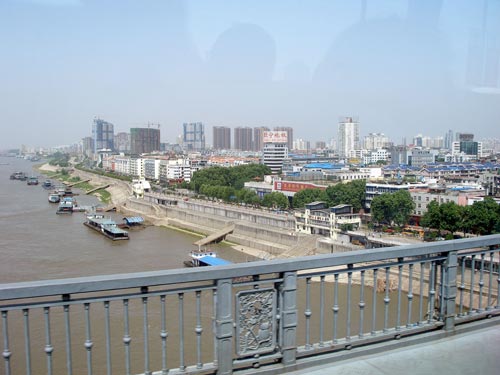
View from the First Bridge
The Wuhan Yangtze River Bridge, also called the First Bridge, was built over the Yangtze River in 1957, carrying the railroad across the river. Before this bridge was built it could take up to an entire day to barge railcars across. Including its approaches, it is 5,511 feet long, and accommodates both a double-track railway on a lower deck and a four-lane roadway above.

The Second Bridge
The Second Bridge, a cable-stayed bridge, has a central span of over 1,300 feet and a total length of almost 15,350 feet. Its main bridgeheads are each 295 feet high, pulling 392 thick slanting cables together in the shape of double fans. Completed in 1995, the bridge's six lanes are designed to handle 50,000 motor vehicles every day.
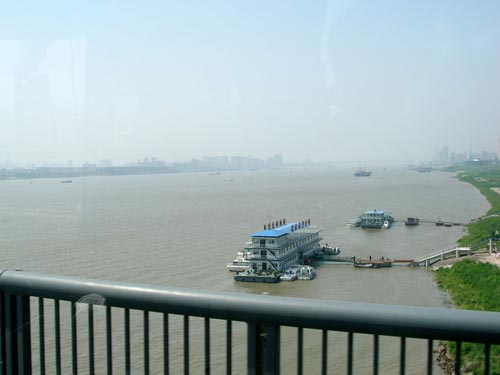
View of the Yangtze River from the Second Bridge

Qingchuan Bridge crosses over the Han River. It is also called Rainbow Bridge because of the red arch.

A view from the bridge of where the Han River meets the Yangtze

A man pulls his wares on a cart.

Cycling with a loaded cart against traffic

A street sweeper seems ignorant of the enormous vehicles flying past her.

More goods piled high
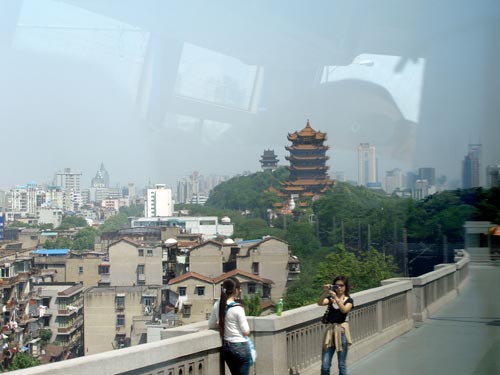
The Yellow Crane Tower is located on Snake Hill.
The Yellow Crane Tower was first built in 223 by Sun Quan (182 - 252, King of Wu) as a watchtower for his army. After hundreds of years, its military function was gradually forgotten and the tower was enjoyed mainly as a picturesque location. During the Tang Dynasty (618 - 907), it became a popular tourist attraction. During the centuries, the tower was destroyed and rebuilt several times. In 1884, it was completely destroyed in a fire and was not rebuilt until 1981. The tower had different architectural features in different dynasties, however, the tower which stands today is based on the one designed during the Qing Dynasty.
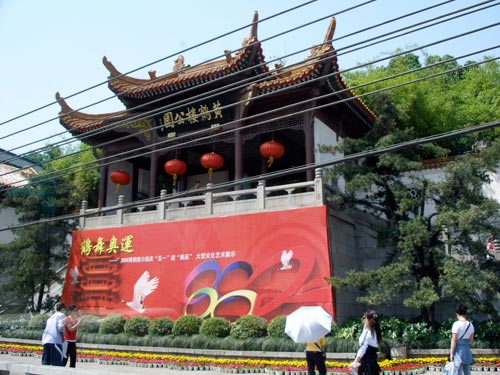
Entrance to the Yellow Crane Tower
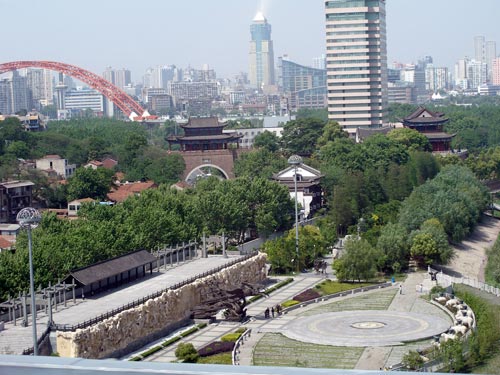
The Qingchuan Pavilion (far right, at the foot of the skyscraper) was first established here between 1522 and 1567 during the Ming Dynasty.
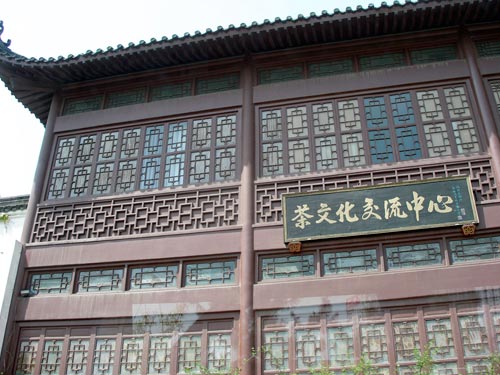
Another impressive building
return • continue
|
|